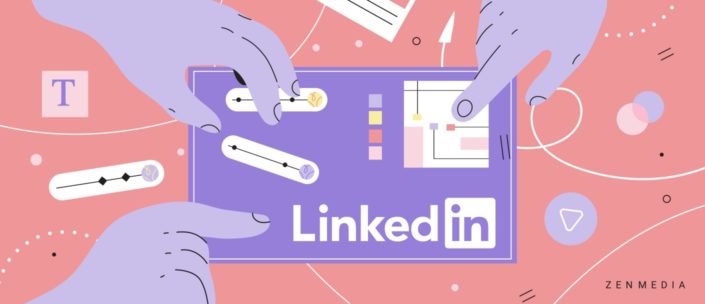Bringing together large corporations, small businesses, and employees, LinkedIn is easily one of the best platforms for B2B marketing. So, what’s step one for building a strong LinkedIn following? Learning the algorithm.
As with any social media platform, Linkedin’s algorithm favors certain types of content. Earn favor with the algorithm, and your content will be consistently present in your follower’s feeds—creating strong visibility.
Fail to, and your hard work—writing, designing, editing posts—will go unnoticed.
Like Facebook, LinkedIn prioritizes user engagement. But unique to LinkedIn is its four-step process to evaluate content across the platform. Ready to learn those four steps and crack the LinkedIn code? Let’s go!
LinkedIn’s 4-step evaluation process
- When any piece of content is published, LinkedIn bots evaluate it and categorize it into one of three options: spam, low-quality, or clear. Of course, you always want your posts to be “clear,” but there’s still hope if a post is deemed “low-quality.”
- LinkedIn tests your content with users. In true social media fashion, LinkedIn lets your audience decide if your content should reign supreme or fall flat. In this phase of the process, your post needs to avoid users marking it as spam or asking LinkedIn to “hide” it from their feed.
- In the third step of the process, LinkedIn starts awarding content points! Once your post has passed the content testing with your LinkedIn connections, LinkedIn begins to weigh the likes (one point), comments (two points), and shares (three points). The post’s score decides its fate. Either it will rise to the occasion, scoring high and therefore earning a place in more users’ feeds, or it will score low and be demoted to a low-quality post.
- The last step in the process is for LinkedIn’s human editors to weigh in. If your post earns enough points to impress the platform, it will be reviewed by editors at LinkedIn who decide if it is worthy of sharing with users outside of your network (like in the “trending content” area or in the news feeds of users who have interacted with content similar to yours).
So now that we know the inner workings of the LinkedIn algorithm’s method—both bot-based and human-based—how do we use this information as we craft our social media marketing strategy?
We create our own 4-step process to earn algorithm favor, of course.
- Optimize post time.
- Prioritize user engagement.
- Keep it on-platform.
- Take advantage of new features.
Optimize post time.
Knowing the right time to post on any social platform can give your content a huge leg up on the competition (and there’s a lot of it). Luckily for LinkedIn marketers, the platform has a fairly straightforward post-time optimization window, and it’s obvious if you think about who the platform’s users are.
Since LinkedIn is a professional platform for businesses, organizations, and employees, most engagement tends to happen between 9 a.m. and 5 p.m. on weekdays. But to further narrow it down, peak posting times tend to be around people’s lunch hour (typically between noon and 1 p.m.). And according to research from HubSpot, B2B content thrives:
- Before work hours (between 7 and 9 a.m.)
- During lunchtime (between 11:30 a.m. to 1 p.m.)
- On home-bound commutes (between 5 and 6 p.m.)
Prioritize user engagement.
The first 60 minutes after posting are the most important for determining the success of the content. This is phase two of the LinkedIn algorithm’s process outlined above. Engagement on the post, including reactions, comments, and shares are the priority here. Aim for 20 or more engagements to please the LinkedIn bots and send your post positively into phase three.
Like we discussed above, the third phase of LinkedIn’s quality-control process awards points for likes, comments, and shares. So what are the best ways to ensure engagement with your post? Notify employees about the new post and ask them to engage with the post. When they do (and especially when users outside of your organization do), be sure to respond to every comment with either a reply or a reaction. Another option is to mention other users and use hashtags.
Another important metric that isn’t explicitly mentioned in LinkedIn’s algorithm process but does come into play is “dwell time.” Dwell time measures the amount of time a user spends on a particular post. From LinkedIn’s perspective, dwell time indicates whether a user is likely to engage with a post or not. From a marketing perspective, dwell time means your post must capture users’ attention and also hold it.
Why does LinkedIn measure dwell time? Initially, the platform-based content success solely on the likes, comments, and shares. This made it simpler for users to form “engagement pods” where users are committed to engaging with each other’s posts. This is great for boosting engagement metrics, but if your post has a ton of engagement, but no one is spending any time actually reading the caption or watching the video, that tells LinkedIn that the post may not be worthy of being pushed to a broader audience. Think of it as a safeguard for LinkedIn to ensure that they don’t accidentally boost a post into virality when the content isn’t really viral-worthy.
Related read: 6 Tips to Grow Your LinkedIn Community
Keep it on-platform
This is where LinkedIn gets a little greedy. The platform prioritizes content that is created on-platform, meaning that it doesn’t link out to a separate website. You can still post all kinds of content–videos, text posts, images, etc.—but LinkedIn would prefer you use its publishing tools, so native content will almost always bring in a larger audience.
There are two ways to create native content on LinkedIn. First, for short-form content, users can use the space provided for a LinkedIn update. Think of it like a Twitter post, and keep this content short and sweet.
Secondly, LinkedIn offers its own article publishing options, so users can compose long-form content native to the platform. Long-form content that performs well, per LinkedIn’s 4-pronged algorithm’s standards, is in the running to be featured on LinkedIn Pulse. LinkedIn Pulse, which used to be a separate content hub on the social platform, is now integrated into every user’s newsfeed, which means that using LinkedIn’s preferred publishing tools and nailing the engagement metrics could skyrocket your post to a much broader network. In turn, publishing valuable content that gets recognized on LinkedIn positions you as an authority on your topic, which will only help brand awareness and trustworthiness.
Related read: How to Build a Bulletproof LinkedIn Content Strategy
Take advantage of new features.
Like most social media, early adopters of the platform and new features within the platform usually see a boost above their competitors. With the plethora of new features dropped to LinkedIn this year (hello, LinkedIn Newsletters!), companies that adopt them early will have the opportunity to test and master them before they become old news.
With 740 million users and 55 million companies on Linkedin, the best way to cut through the noise and make a real impact is by creating a strong strategy, and that starts with knowing the platform and recognizing that everything you know is subject to change! Normally, social media platform changes are made to help their users, to boost engagement, and to make things easier—but each shift has fallout, so make sure that you regularly check out any new features and consider how you may need to alter your strategy accordingly.
Want help mastering your LinkedIn presence? We can help. Reach out.







